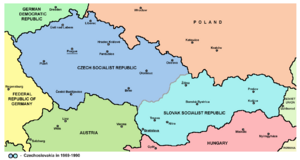History of Czechoslovakia (1989–1992) facts for kids
The final years of Czechoslovakia were a time of big changes. It all began with the Velvet Revolution in November 1989. This peaceful revolution ended the communist government. The country then went through a few more years of change. It finally split into two separate countries on January 1, 1993. These new countries were the Czech Republic and Slovakia.
Contents
The Velvet Revolution
This section will explain how Czechoslovakia changed from a communist country.
What Led to the Revolution?
In the late 1980s, the Soviet Union had a new leader, Mikhail Gorbachev. He started new policies called perestroika (meaning "restructuring") and glasnost (meaning "openness"). These policies aimed to make the economy and government more open.
Czechoslovakia's leader, Gustáv Husák, said he would follow these ideas. But he was very careful. He warned against changing things too quickly. In December 1987, Husák stepped down as head of the Communist Party. He remained president for a while.
Miloš Jakeš became the new leader of the Communist Party. He was also cautious. He promised to continue slow reforms. He wanted to make the economy better with new technology. But he also said there would be no "retreat from socialism." This meant the Communist Party would stay in charge.
However, many ordinary people in Czechoslovakia were unhappy. They wanted more freedom. They could watch TV channels from Western Europe in some areas. This showed them how people lived in other countries. They also saw how reforms were going in places like Poland and Hungary.
Growing Protests
People started to speak up more. In December 1987, about 500,000 Catholics signed a petition. They asked for religious freedom. This was a very large protest for Central Europe at the time.
The first big anti-Communist protest happened on March 25, 1988. It was called the Candle Demonstration in Bratislava. About 2,000 to 10,000 Catholics gathered peacefully. They asked for religious freedom and basic rights. The police broke up the protest with force. Many people were arrested.
More protests followed.
- On October 28, 1988, people protested in Prague and Bratislava. This date was important because it was the anniversary of Czechoslovakia's founding in 1918.
- In January 1989, protests remembered Jan Palach. He was a student who set himself on fire in 1969 to protest the Soviet invasion.
- On August 21, 1989, people protested the 1968 Soviet military intervention.
- Another protest took place on October 28, 1989.
The Revolution Begins
The anti-Communist revolution truly began on November 16, 1989. Students in Bratislava held a demonstration for democracy. The next day, Czech students held a similar protest in Prague. These student protests quickly grew.
The Communist Party leaders saw that they could not stop the changes. On November 24, the entire Politburo, including Jakeš, resigned. Just five days later, the government removed a part of the Constitution. This part had said the Communist Party had a "leading role" in the country. This was a huge step towards democracy.
After the Velvet Revolution
In December 1989, Husák, who was still president, swore in a new government. For the first time in a long time, Communists were a minority in the government. Husák resigned shortly after. This marked the official end of the old system.
The first free elections in Czechoslovakia since 1946 took place in June 1990. More than 95% of people voted. Two main groups, Civic Forum and Public Against Violence, won many votes. They gained a strong majority in the federal parliament.
The new parliament worked to make Czechoslovakia a true democracy. They held fair local elections in November 1990. This brought big changes to towns and cities.
Civic Forum had succeeded in overthrowing the communist government. But it found it hard to be a governing party. It eventually split into different political groups. The Civic Democratic Party, led by Václav Klaus, became very important. Other new parties also formed, like the Czech Social Democratic Party.
The Country Splits Apart
After the Velvet Revolution, the leaders of the Czech and Slovak parts of the country had different ideas. They found it hard to agree on how to run the country together.
On November 25, 1992, Czechoslovakia's parliament voted. They decided to split the country into two separate nations. This happened on January 1, 1993. The two new countries were the Czech Republic and Slovakia. This peaceful split is known as the "Velvet Divorce."
See also
- Economy of the Czech Republic#1989–1995



